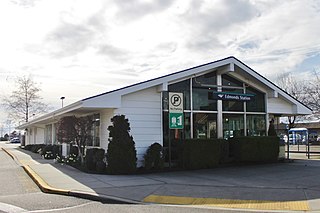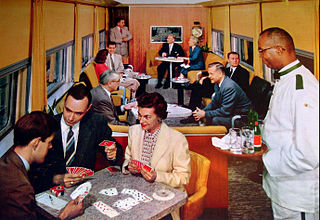
The Great Northern Railway was an American Class I railroad. Running from Saint Paul, Minnesota, to Seattle, Washington, it was the creation of 19th-century railroad entrepreneur James J. Hill and was developed from the Saint Paul & Pacific Railroad. The Great Northern's route was the northernmost transcontinental railroad route in the U.S.

The Empire Builder is a daily long-distance passenger train operated by Amtrak between Chicago and either Seattle or Portland via two sections west of Spokane. Introduced in 1929, it was the flagship passenger train of the Great Northern Railway and was retained by Amtrak when it took over intercity rail service in 1971.

The Amtrak Cascades is a passenger train corridor in the Pacific Northwest, operated by Amtrak in partnership with the U.S. states of Washington and Oregon. It is named after the Cascade mountain range that the route parallels. The 467-mile (752 km) corridor runs from Vancouver, British Columbia, through Seattle, Washington and Portland, Oregon to Eugene, Oregon.

The Coast Starlight is a long-distance passenger train operated by Amtrak on the West Coast of the United States between Seattle and Los Angeles via Portland and the San Francisco Bay Area. The train, which has operated continuously since Amtrak's formation in 1971, was the first to offer direct service between Seattle and Los Angeles. Its name is a combination of two prior Southern Pacific (SP) trains, the Coast Daylight and the Starlight.

The North Coast Limited was a named passenger train operated by the Northern Pacific Railway between Chicago and Seattle via Bismarck, North Dakota. It started on April 29, 1900, and continued as a Burlington Northern Railroad train after the merger on March 2, 1970 with Great Northern Railway and the Chicago, Burlington and Quincy Railroad. The next year, it ceased operations after the trains which left their originating stations on April 30, 1971, the day before Amtrak began service, arrived at their destinations.

The North Coast Hiawatha was a streamlined passenger train operated by Amtrak between Chicago, Illinois, and Seattle, Washington. Operating from 1971 to 1979, the train was a successor to the Northern Pacific Railway's North Coast Limited and Mainstreeter. Its name is a combination of North Coast Limited and Hiawatha, a Chicago, Milwaukee, St. Paul and Pacific Railroad train whose route it followed east of Minneapolis–St. Paul. Created at the behest of the United States Congress, the North Coast Hiawatha enjoyed an uncertain existence before being discontinued in 1979. Since then, there have been several unsuccessful attempts to restore it.

Midway is a former Amtrak intercity train station in the Midway neighborhood of Saint Paul, Minnesota, United States. It was last served by Amtrak's daily Empire Builder and, for a time, by the North Star, as well as briefly by the North Coast Hiawatha.

An SDP40 is a 6-axle passenger diesel-electric locomotive built by General Motors Electro-Motive Division (EMD) between June 1966 and May 1970.

Pacific Central Station is a railway station in Vancouver, British Columbia, Canada, which acts as the western terminus of Via Rail's cross-country The Canadian service to Toronto and the northern terminus of Amtrak's Cascades service to Seattle and Portland. The station is also Vancouver's main intercity bus terminal. The station is wheelchair accessible and is staffed with full Via services. The station is a candidate for the northern terminus of a possible future high-speed rail line being considered primarily by the US state of Washington.

The Olympian and its successor the Olympian Hiawatha were passenger trains operated by the Chicago, Milwaukee, St. Paul and Pacific Railroad between Chicago and the Pacific Northwest. The Olympian operated from 1911 to 1947 and was, along with its running mate the Columbian, the first all-steel train to operate in the Pacific Northwest. The streamlined Olympian Hiawatha operated from 1947 to 1961 and was one of several Milwaukee Road trains to carry the name "Hiawatha." The Olympian Hiawatha was designed by industrial designer Brooks Stevens and included the distinctive glassed-in "Skytop" observation-sleeping cars. It later featured full-length "Super Dome" cars.

Edmonds station is a train station serving the city of Edmonds, Washington, in the United States. The station is served by Amtrak's Cascades and Empire Builder routes, as well as Sound Transit's N Line, a Sounder commuter rail service which runs between Everett and Seattle. It is located west of Downtown Edmonds adjacent to the city's ferry terminal, served by the Edmonds–Kingston ferry, and a Community Transit bus station. Edmonds station has a passenger waiting room and a single platform.

The Northern Transcon, a route operated by the BNSF Railway, traverses the most northerly route of any railroad in the western United States. This route was originally part of the Chicago, Burlington and Quincy Railroad, Northern Pacific Railway, Great Northern Railway and Spokane, Portland and Seattle Railway systems, merged into the Burlington Northern Railroad system in 1970.

St. Cloud station is an Amtrak intercity train station in St. Cloud, Minnesota, United States. It is served by the daily Empire Builder on its route connecting Chicago, Illinois to Seattle, Washington and Portland, Oregon. The next stop westbound is Staples while the next stop eastbound is Saint Paul Union Depot.

The Pacific Northwest Corridor or the Pacific Northwest Rail Corridor is one of eleven federally designated higher-speed rail corridors in the United States and Canada. The 466-mile (750 km) corridor extends from Eugene, Oregon, to Vancouver, British Columbia, via Portland, Oregon, and Seattle, Washington, in the Pacific Northwest region. It was designated a high-speed rail corridor on October 20, 1992, as the one of five high-speed corridors in the Intermodal Surface Transportation Efficiency Act of 1991 (ISTEA).

The Boise Depot is a former train station in the western United States, located in Boise, Idaho. Opened 98 years ago in 1925, it is listed on the National Register of Historic Places (NRHP). At an elevation of 2,753 feet (839 m) above sea level on the rim of the first bench, the depot overlooks Capitol Boulevard and the Idaho State Capitol, one mile (1.6 km) to the northeast.

The Pacific International was a passenger train operated by Amtrak between Seattle, Washington and Vancouver, British Columbia. It was Amtrak's first international train service, operating from 1972 until 1981.

The Mainstreeter was a passenger train on the Northern Pacific Railway between Chicago, Illinois, and the Pacific Northwest from 1952 to 1971. When the North Coast Limited got a faster schedule in November 1952 the Mainstreeter was introduced, running roughly on the North Coast's old schedule but via Helena. Unlike the North Coast the Mainstreeter was not a true streamliner as it carried both new lightweight and traditional heavyweight coaches. It replaced another train, the Alaskan. The name referred to the Northern Pacific's slogan, "Main Street of the Northwest." While Amtrak did not retain the train as part of its initial route structure, it created a new train named the North Coast Hiawatha several months afterwards. That train ran until 1979.

The Point Defiance Bypass is a 14.5-mile-long (23.3 km) rail line between the cities of DuPont and Tacoma in Pierce County, Washington. It was originally built by the Northern Pacific Railway – the Tacoma–Lakewood segment in 1874 as part of the Prairie Line, and the Lakewood–DuPont section in 1891. Passenger service on the lines declined after the 1914 completion of a flatter route along Puget Sound, and ended entirely in 1956.

Glendive Depot is an office building and former train station in Glendive, Montana. The Northern Pacific Railway established the town in 1881 and opened the first depot in 1882. The present depot building was built in 1922 and is part of the Merrill Avenue Historic District.
The Canadian and later, Canadian-Niagara, was the longest running named international train from Chicago to Upper Canada via Detroit, for its first two decades running to Montreal. This overnight train was operated by the Michigan Central Railroad from Chicago to Detroit, and in a pool arrangement, it operated over Canadian Pacific Railway tracks and used the same train number from Detroit eastward. The train would carry a second section, bound, variously for Buffalo or New York City via Buffalo.



















